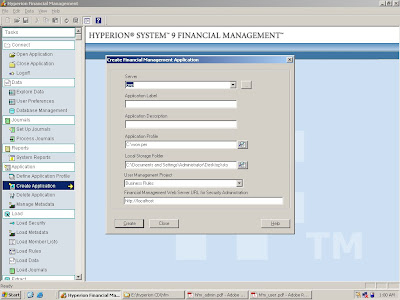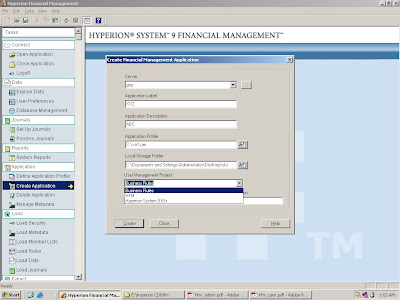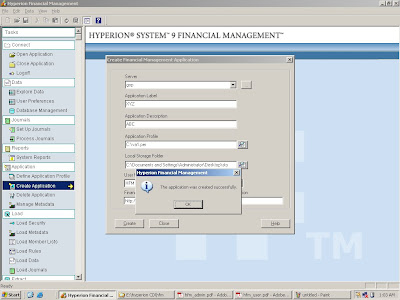Monday, March 9, 2009
FIND MY ARTICLES IN MY WEBSITE http://hyperionconsultancy.com/
http://hyperionconsultancy.com/
Sandeep Reddy Enti
Saturday, August 9, 2008
Hyperion and Ethics
Essbase and Ethics
It’s not of Essbase and at the same time, it’s not anything but Essbase. I have no idea of what can possibly be the apt title to this blog/article/topic. For a change, this is not a technical article. Yet, it’s worth a read. It’s about an incident, which had happened to me. I have got a mail from a gentleman stating his interest in learning Essbase and needs my support. As this is very common to me every other day, I had mailed him in return acknowledging positively that I am willing to share the knowledge which I have gained in years of my experience.
That the gentleman called me and started narrating his situation. He is an Indian, who went to US and had worked for some time in the field of BO .He has moved into Hyperion now (as he realized the demand of Hyperion in US market.) .He has absolutely no experience in Hyperion what so ever.
I opened my conversation by asking my conventional question "Hi, I am glad that you'd called me. Tell me, what I can do for you “ Adding more I have asked few more questions. "So, how many years of experience do you have ,and what tool or subject would you like me to support you , or do you have any specific burning production problem" Now, it’s his turn to reply. He said “I have worked in BO, and now shifted my field to Essbase and Planning, and I need your help" I was surprised to see people, who change their field for as per market demand, rather their inherent and latent talent, passion towards a field. With no exception, I respect all who change their fields, when they feel that they've learnt enough and had given back to the field. .These gentlemen change for sake of change (rather truth is more dollars).These guys add no value to any field for that matter.
Resuming the conversions .He had an interview, which was scheduled and he is not prepared to give. I felt sorry, as he had not much time to prepare, and I had promised him to spend time in the nights coming ahead, before interview, so that he can be comfortable in interview.
He said in a broken words “my request is, I wanted you to attend interview, which is a telephonic one, on my behalf’. Its was more than a shock to me. I could answer nothing .I was calm. He added “It’s a very common thing in US, and we pay some $ 500 for that”. I answered “I don’t do this, had never done. I can train you in Essbase or any other tool. But I don’t do this”
He added by explaining how important an employment is to him. I had nothing to say on it. Then, I thought, it must be a joke for a moment .I wanted to reconfirm this prevailing bad practice, and had requested him to mail me his resume and job description.
He finally said “Yes, I ll mail you in 5 mins, and I expect a positive response”.
I had got a mail, his resume states more than 8 years experience in Hyperion essbase , HFM and planning .
His job description clearly reflects the importance of the resource, which they have been looking for. This resource is going to complement decision support team. For once, I was not proud to be an Indian .If this is prevalent in US, then I would request all candidates and all dubious consultancies, who fake experience and provide a lesser competent resource to companies, not to do this any more. One needs to understand that Hyperion, which is a part of Business Performance Management, helps DSS (Decisions science support) of an organization /bank...etc.Its a crucial position/role .Do not entertain non-specialists.its hits the decision making of any company.
This would imbalance the situation and in long term, it’s harmful to the field of BPM. I know many, who work more than 12 hours a day, and seek no credit out of their work. They strive towards adding lot of value to the field (or to Hyperion tools). Unqualified people, who fake experience and do get credit .This would definitely imbalance the situation.
When once goes to US for job, they, without their consciousness, represent their country .Manners of them are closely observed to judge a nation .As nation is nothing but people. I don’t want India to be labeled as moral less and valueless.
Finally, I would plea to all, to work hard and dollars will come when they have to .Don’t drop your self to any level for money.
Sandeep Reddy Enti
Saturday, August 2, 2008
HFM Application Creation
This blog along with my podcast has to be listened to make any sense.By the end of this , one would be able to creat an application in HFM. One can find my podcast in http://analytiks.mypodcast.com/
Before we start creating an application in HFM ,we need to define application profile .Click on "Define Application Profile" as shown in the fig
 Next, type english as a language
Next, type english as a language Here, you need to opt out of the options available , for this blog purpose ,we select standard .But , remember it changes with requirements.
Here, you need to opt out of the options available , for this blog purpose ,we select standard .But , remember it changes with requirements. 
Next is time periods and frequencies ,as shown in the below mentioned fig
Tuesday, July 29, 2008
Slowly Moving Dimensions
This is a small blog and its intended audience is everyone ( beginners and exp guys).By the topic of it ,I know readers must be surprised and say
“It’s a datawarehousing concept,so why is it here?”
You are right, it’s a datawarehousing concept and many of them ,who had worked on warehousing or who are familiar with data warehousing might be aware of this .
But , our question still remains
“What is it doing here?”
In our newer version of Essbase 11, of many new features , we have a new feature called “Varying Attributes”.This varying attributes is close to SCD’s of dimensional modelling ( SCD:Slowly changing dimensions).
The new feature of “Varying Attributes” helps a user in his analyses even further.I shall talk more on varyign attributes and how does it enhance the tool and helpful to user for his analyses in my next blog.
You can also find a podcast on “Varying attributes” in
http://analytiks.mypodcast.com/
Sandeep Reddy Enti
Tuesday, July 1, 2008
I am new to/learning Essbase, do I need to understand warehouse concepts? 1
The above subject is a question, I have been asked by few aspiring essbase learners. This article is for beginners. Expertise in data warehousing is not a pre requisite to work on essbase/ learn essbase , but conceptual clarity of the role of data warehouse in an enterprise is required.
Read and understand data warehouse to an extent, you can imagine where our OLAP engine fits in ,and more importantly to get a clear picture of the data flow. Here, I mean data flow from disparate data from heterogeneous data sources (which are in independent silos) to smart looking report, which provides valuable information and also instrumental in decision making .
The objective of this article is to make an image, which portrays the transformation of raw data into valuable information on reports.
Step 1: Let’s take an example of a bank. Bank has many departments, and each department has different application to process its departmental data. Where there is data, there is a database. As there are different departments, and different applications for specific needs, you have different data bases also.
Now, we are with different database (might be oracle, SQL server .DB2…etc).
Just imagine, few squares in different colors as few databases.
(I‘ll repeat, these databases have data from different departments of a bank)
Step 2: After drawing few colorful squares on left hand side , we have an ETL application right to it .ETL(Extraction , transformation and load). Its like a black engine, and has connecting thread to all the colorful squared (our databases) ones.
This ETL engine has the capability to pull the data, and transform into a common data type / desired format and load it into a common repository/storage place.
Eg: If I have 3 databases, and all these 3 database has information about a customer named ‘Srikanth’.
Database 1, might have stored as ‘Sreekanth’
Database 2, might have stored as ‘Shrikanth’
Database 3, might have stored as ‘Shreekant’
But its all of only one customer, so ETL will take care of all the cleaning required and put into storage, and make it sacrosanct.
So far, we have colorful squares (which are different database), right to it we have an ETL engine , which is strongly connected to the squares .Right to ETL engine ,we have a sacrosanct storage ,where the ETL puts in all the data.
Step 3: The repository/storage, which we had ended with in Step 2 is data warehouse.
Now, have an OLAP engine, I’ll fix it right to warehouse (ware house has data of all departments of bank).
Before I pull the data from warehouse and start building beautiful cubes. I’ll spend time on the final analyses and reports, which a decision maker/user would be interested to know of his business (here, its bank). When I am clear with the final report picture, I shall connect OLAP engine and pull the data, which is relevant to my final analyses/report purpose. Of the pulled data from warehouse, I build cubes.
Now, I have squared databases on the left hand side , an ETL machine connected to these databases .Right to ETL ,I have warehouse , the repository where ETL puts in data . Right to warehouse, we have our essbase engine (and cubes i.e. OLAP cubes).
Step 4: As users are not as smart as techies :), they need information in presentable manner. We build a reporting platform, and connect this reporting platform to our OLAP cubes. Reporting platform might be your Excel, analyzer, Interactive reporting….etc.
Now, we have a report platform, where you have information of the required analyses/report, which runs across the departments. This information has its geneses in the different databases.
The data has flown from different databases ,and ETL had put the data into warehouse ,and OLAP made even more beautiful cubes ,and the final reports, which a users looks at , is from the cubes.
Recapitulating ,
On left hand side, we have different databases, and ETL connects all, puts data into warehouse. OLAP talks to warehouse and makes cubes and provides information to reporting platform.
I could have simply pasted an architecture diagram, and made it simpler, but, now after this explanation, I think you guys wont forget the basic architecture and OLAP location in it.
As I had told you, its for beginners, If anyone is interested to know advanced topics of warehouse and role of essbase. mail me
One can find audio (MP3) on the same topic in the Podcast - http://analytiks.mypodcast.com/
Sandeep Reddy Enti
Monday, June 23, 2008
Dense or Sparse - Part 1
Undoubtedly, it’s the world of ASO. But, BSO is not dead. In the initial days of cube designing, one would always say to himself .
“This looks like dense, hmm, may be sparse …I am not sure”
After this topic of my blog, I’ll try to reduce the number of people questioning this one.
I have always been told by many that I explain things from basics. The same goes here too.
First, we’ll spend some time on dimensional model.
No, don’t close the window right now .I mean, only 2 terms of dimensional model.
I shall talk of
FACT
DIMENSION.
Ex: The sales of Honda cars, in Charlotte of North Carolina, in the month of Jan of year 2008 are 5000.
Request all to re look at the above sentence and pull out the dimension names
In the first go, I can make out the following
1. Honda
2. Charlotte
3. Jan
More scrutiny would give more details
4. Sales
5. 2008
6. 5000
Now, what are these numbers or names suggest .Lets try with the names of dimensions
1. Products (from Honda)
2. Place (from charlotte)
3. Time (from Jan)
4. Sales (let it be this way, for some time)
5. Time (from 2008 year)
6. 5000 (this is the number, which is of sales)
Now, let’s refine it further.
Products
Place
Time
Sales
Lets assume that -
There might be more products i.e. Honda, GM, merc
Place, In US, North Carolina is a state and charlotte is one of the cities
Time, this one has a year , quarter , month ..Etc
Now, the final outline can be made with the limited knowledge which we had gained from the above
-Time
-Q1
-Q2
-Q3
-Place
-States
-North carolina
-Charlotte
-Sales (Lets keep is the same , for some more time )
This looks near to our outline.
Fact table contents are the ones, which a user/analyst/decision maker is interested to look at, and understand the business of his company.
The fact table content, when seen against other dimensions ( in our case , time , place , product) gives a user more information about his company.
I.e. Sales in a place, in the month of XYZ for a product.
Now, we are clear with FACT and DIMENSION and what fills them in a dimensional model
Coming to the DENSE, SPARSE, this is our focus
Generally, Dense has contents of fact table and sparse has the rest of dimensions.
To elaborate, Sales is the one, which is a measure/ metric which a typical user would be interested to know of his company.
If you had looked at the definition given in the DBAG (our Bhagvathgeetha) , it says that it has the maximum probability of occurance .
Now ,its easy to interpret that , we might ask questions like
Sales of Honda in Jan
Sales of GM in New jersey
Sales of Honda in 2000
We would be posing questions like
Honda in jan in New Jersey…? And what …can’t even make a question from user’s perspective
Thus, ‘sales’ as a dimension member has max probability of occurrence.
Hence, it’s a dense member and other dimensions like Place, Time , Product are sparse .
I shall continue this post with topic
DENSE OR SPARSE 2..
Questions feed back , I invite
I invite blog topics too ,as this topic is also made on demand and need basis.
Hope it helps
Sandeep Reddy Enti
Tuesday, June 17, 2008
Is Hyperion Certification easy to clear ,do i have advantage in terms of job or , Do i get interview call if I am certified
I come across these question from aspiring Hyperion professonals. My advice to them is not to veiw hyperion certification as a ticket to your job , nor the one, which can impact your appraisal
Professionals ,who have worked in an industry, in a domain and had spent substantial amount of time meddling with a hyperion tool , and want to check whether they are good enough to the Hyperion tool ,are the eligible people to can take the certification.
Another common question , Is HCC in demand or HCD? Let me clear one thing here , HCD suits to the professionals who have programming experience and work on development part of Hyperion projects .
Coming to the HCC, these professionals are the ones ,who go to clients , interview them , understand the business , its requirements and provide solutions .They are active in design phase. This needs more experience than just programming.
Hence, if professionals want to take these certifications , then HCD followed by HCC is an ideal order .
For beginners , i would request them to gain some real time experience .Dont plan certification ,based on your PDF and freely downloaded software /work experience .There is a lot of difference . One might clear certifications , but that would misguide the industry ,when you get edge over experienced and worthy Hyperion professionals
Sandeep Reddy Enti






